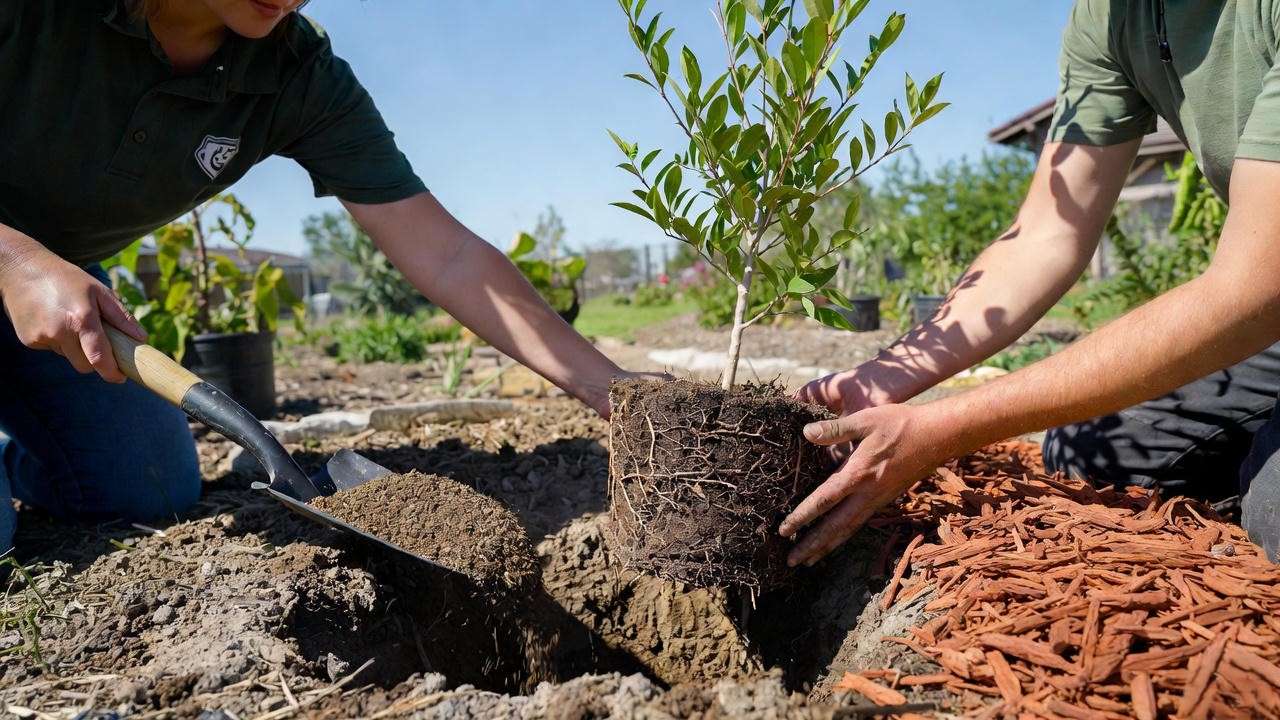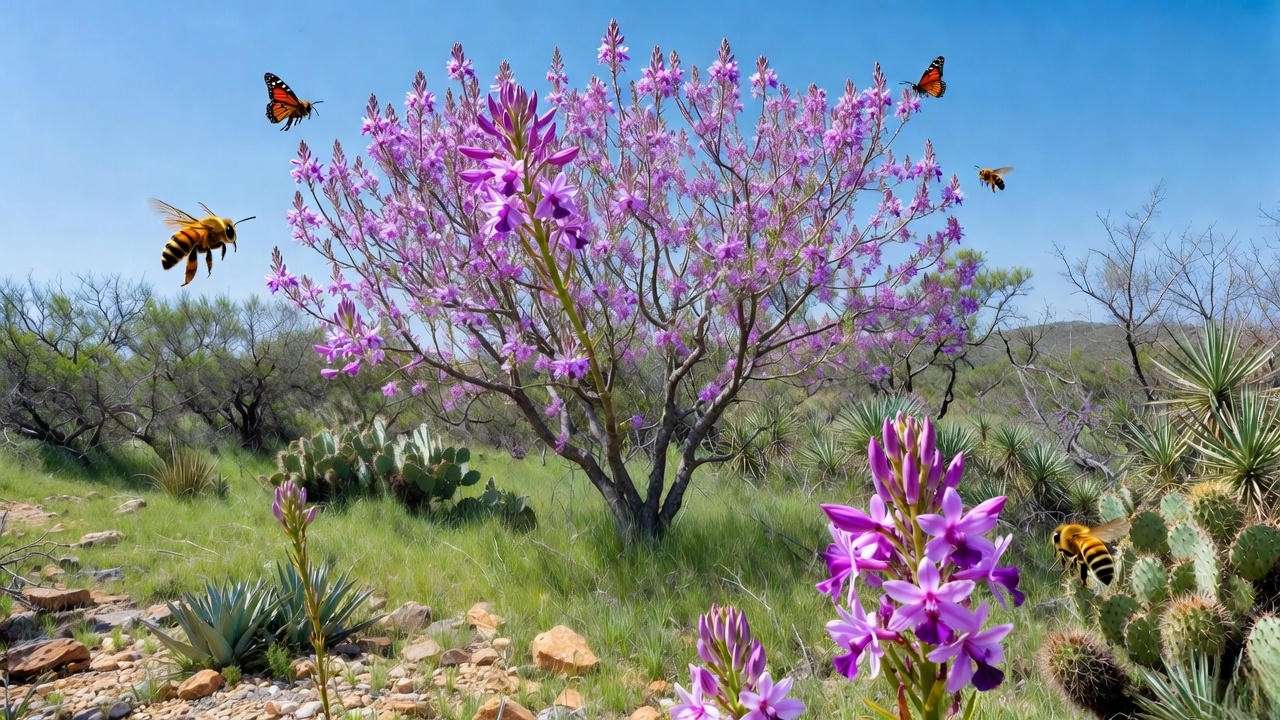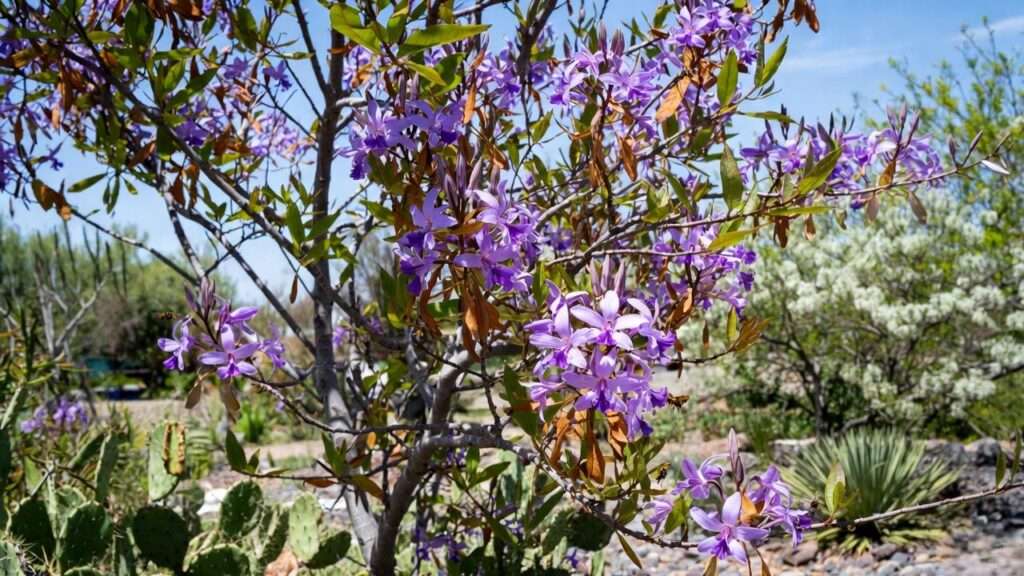Picture this: a cascade of delicate, orchid-like blooms in soft white or pink, swaying gently in your Texas garden, turning heads and attracting hummingbirds 🐦. That’s the magic of the anacacho orchid tree texas gardeners are raving about! Native to South Texas and the Hill Country, this drought-tolerant gem (Bauhinia lunarioides) is a low-maintenance showstopper perfect for our state’s challenging climate. Whether you’re a seasoned gardener or a beginner, growing a stunning anacacho orchid tree in Texas is easier than you think with the right know-how. In this guide, I’ll share expert tips honed over 15 years as a Texas Master Gardener to help you plant, care for, and showcase this beauty, ensuring vibrant blooms year after year. Ready to transform your landscape? Let’s get started! 🌱
What Is the Anacacho Orchid Tree? 🌳
Botanical Background and Characteristics
The anacacho orchid tree, scientifically known as Bauhinia lunarioides (sometimes Bauhinia congesta), is a small deciduous tree or shrub that brings elegance to any garden. Growing 6-12 feet tall and wide, it boasts heart-shaped, bilobed leaves and clusters of fragrant, orchid-like flowers in white or soft pink. Blooming from spring to early summer, these flowers resemble miniature orchids, earning the tree its charming name. Native to South Texas, the Texas Hill Country, and northern Mexico, this plant thrives in arid and semi-arid environments, making it a natural fit for Texas landscapes.

Why It’s Perfect for Texas Gardens
What makes the anacacho orchid tree a Texas favorite? Its resilience. This tree is drought-tolerant, heat-resistant, and adaptable to various soil types, from rocky limestone to sandy loam. It’s a star in xeriscaping, requiring minimal water once established, which is ideal for water-conscious gardeners. Plus, its blooms attract pollinators like bees, butterflies 🦋, and hummingbirds, supporting local ecosystems. “The anacacho orchid tree is a cornerstone of sustainable Texas landscaping,” says Dr. Emily Carter, a horticulturist with Texas A&M AgriLife Extension. “Its beauty and ecological benefits make it a must-have for native plant enthusiasts.”
Understanding Texas Growing Conditions for Anacacho Orchid Trees ☀️
Texas Climate and Soil Challenges
Texas is a land of extremes, with climates ranging from humid Gulf Coast summers to arid West Texas winters (USDA Zones 8-10). The anacacho orchid tree thrives in these conditions but requires strategic planning. In the Hill Country, rocky limestone soils dominate, while clay-heavy soils are common in East Texas. The tree prefers well-draining soil with a pH of 6.5-8.0, which suits most Texas regions. However, poor drainage or heavy clay can lead to root rot, a common issue in wetter areas like Houston.
Ideal Planting Locations in Texas
For optimal growth, plant your anacacho orchid tree in a spot with full sun to partial shade (at least 6 hours of sunlight daily). South- or west-facing locations are ideal, especially in urban gardens or small yards. In hotter regions like San Antonio, a bit of afternoon shade can prevent leaf scorch. Regional considerations matter: in Austin’s rocky soils, ensure good drainage, while Gulf Coast gardeners should elevate planting beds to avoid waterlogging.
Tip Box: Top 3 Texas Regions for Anacacho Orchid Trees
- Austin: Perfect for rocky Hill Country soils; plant in spring for best establishment.
- San Antonio: Thrives in sunny yards; mulch to retain moisture in hot summers.
- West Texas: Ideal for xeriscaping; choose wind-protected spots to avoid desiccation.
Step-by-Step Guide to Planting Your Anacacho Orchid Tree 🌱
When to Plant
Timing is key for a healthy anacacho orchid tree. In Texas, the best planting seasons are spring (March-April) or early fall (September-October). These periods avoid extreme heat and frost, giving roots time to establish. Avoid planting in summer, as intense heat can stress young trees, or in winter, when unexpected freezes in North Texas can cause damage.
Choosing a Healthy Tree
Start with a strong sapling from a reputable nursery. Look for a tree with vibrant green leaves, no signs of wilting, and a well-developed root system. Check the roots by gently lifting the pot—avoid trees with circling or mushy roots. A 1- to 2-gallon container is ideal for beginners, as it’s easier to manage than larger specimens.

Planting Process
Follow these steps for success:
- Dig the Hole: Make it twice as wide and as deep as the root ball (about 2-3 feet wide).
- Amend the Soil: Mix native soil with compost or limestone gravel for drainage, especially in rocky Texas soils.
- Plant the Tree: Place the tree so the root crown is level with the soil surface. Backfill and tamp gently.
- Water Thoroughly: Soak the soil to settle roots, then mulch with 2-3 inches of organic mulch (e.g., cedar bark) to retain moisture.
- Stake if Needed: In windy areas like West Texas, stake the tree for the first year to prevent leaning.
Example: Sarah, a San Antonio gardener, planted her anacacho orchid tree in spring 2023. By following these steps and mulching heavily, she saw her tree bloom vibrantly the next spring, becoming the envy of her neighborhood!
Essential Care Tips for a Thriving Anacacho Orchid Tree 💧
Watering Needs
Anacacho orchid trees are low-maintenance once established, but proper watering is crucial in the first year. Water deeply (1-2 gallons) once a week during the growing season, allowing the soil to dry slightly between sessions. In humid areas like Houston, reduce watering to prevent root rot. After the first year, water only during prolonged droughts—about once every 2-3 weeks in Texas summers. Overwatering is a common mistake, so always check soil moisture before watering.
Fertilizing for Vibrant Blooms
To encourage those stunning blooms, fertilize sparingly. Use a low-nitrogen, phosphorus-rich fertilizer (e.g., 10-20-10) in early spring, just before blooming. Apply according to package instructions, typically 1-2 pounds for a young tree. Over-fertilizing can lead to excessive foliage at the expense of flowers, so less is more. Organic options like compost tea also work well for eco-conscious gardeners.
Pruning and Maintenance
Light pruning keeps your tree shapely and healthy. Prune in late winter or early spring before new growth begins. Remove dead, damaged, or crossing branches, and shape the canopy to enhance airflow. Avoid heavy pruning, as it can reduce blooms. Clean tools with rubbing alcohol to prevent disease spread. Regular maintenance includes checking for mulch depletion and refreshing it annually.
Pest and Disease Management
Anacacho orchid trees are relatively pest-resistant, but watch for aphids, scale insects, or fungal leaf spots, especially in humid Texas regions. Treat aphids with neem oil or insecticidal soap, applied early in the morning. For fungal issues, improve air circulation through pruning and avoid overhead watering. In arid West Texas, scale insects may appear; use horticultural oil for control. Regular inspections catch problems early.
Expert Tip: How to Spot Early Signs of Stress
- Yellowing leaves: Check for overwatering or nutrient deficiency.
- Wilting: Ensure adequate water and shade during heatwaves.
- Sparse blooms: Verify sunlight exposure and reduce nitrogen fertilizer.
Designing Your Texas Landscape with Anacacho Orchid Trees 🌼
Companion Plants
The anacacho orchid tree shines when paired with Texas-native companions that complement its aesthetic and environmental needs. Consider planting it alongside Texas sage (Leucophyllum frutescens), with its silvery foliage and purple blooms, for a striking contrast. Blackfoot daisy (Melampodium leucanthum) adds low-growing white flowers that enhance the tree’s delicate blooms. For a bolder look, red yucca (Hesperaloe parviflora) offers spiky texture and vibrant coral flower spikes. These drought-tolerant natives thrive in similar conditions—full sun, well-draining soil, and minimal water—creating a cohesive, water-wise garden. Plus, they attract pollinators like bees 🐝 and butterflies, boosting your yard’s ecological value.

Landscape Uses
This versatile tree fits various landscape roles. Use it as a focal point in a small courtyard, where its compact size (6-12 feet) and vibrant blooms draw the eye. In larger yards, plant it as a hedge or privacy screen along property lines, spacing trees 5-7 feet apart for a lush effect. For urban gardens or patios, grow it in a large container for a portable accent, ensuring the pot has drainage holes. Its airy canopy also works beautifully near seating areas, providing dappled shade without overwhelming the space. In xeriscape designs, combine it with gravel paths and succulents for a low-maintenance, modern look.
Comparison Table: Anacacho Orchid Tree vs. Other Texas Ornamentals
| Feature | Anacacho Orchid Tree | Crepe Myrtle | Desert Willow |
|---|---|---|---|
| Height | 6-12 ft | 10-30 ft | 15-25 ft |
| Bloom Time | Spring-Summer | Summer | Spring-Fall |
| Water Needs | Low | Moderate | Low |
| Sun Requirements | Full Sun/Part Shade | Full Sun | Full Sun |
| Best Use | Focal Point, Hedge | Large Yards | Naturalized |
This table helps gardeners choose the right tree for their Texas landscape, highlighting the anacacho’s unique advantages.
Troubleshooting Common Problems with Anacacho Orchid Trees ⚠️
Why Isn’t My Tree Blooming?
Sparse blooms can frustrate Texas gardeners. Common culprits include insufficient sunlight—ensure at least 6 hours of direct sun daily. Over-fertilization with high-nitrogen products promotes leafy growth over flowers, so switch to a phosphorus-rich fertilizer (e.g., 10-20-10). Improper pruning, like cutting in late spring, can remove flower buds. Prune only in late winter to preserve blooms. Young trees may also take 1-2 years to establish before blooming profusely, so patience is key.
Yellowing Leaves or Drooping
Yellow leaves often signal water stress or nutrient issues. Overwatering, especially in clay-heavy East Texas soils, can cause root rot—check soil moisture and improve drainage if needed. Underwatering during establishment or drought can lead to drooping; water deeply once a week for young trees. Nutrient deficiencies, like low iron in alkaline soils, may also cause yellowing. Apply a chelated iron supplement in spring if symptoms persist.
Surviving Texas Weather Extremes
Texas weather throws curveballs, from scorching summers to occasional freezes. Protect young trees during heatwaves with extra mulch and afternoon shade cloth. In North Texas, where freezes dip below 20°F, wrap trunks with burlap or frost blankets in winter. During heavy Gulf Coast rains, ensure proper drainage to prevent root issues. “My anacacho survived the 2021 Texas freeze with just a frost blanket and mulch,” shares Austin gardener Maria Lopez. “It bounced back with stunning blooms by spring!”
Environmental and Cultural Benefits of Anacacho Orchid Trees 🌍
Supporting Texas Wildlife
The anacacho orchid tree is a pollinator magnet, drawing bees, butterflies 🦋, and hummingbirds with its nectar-rich blooms. This supports Texas’ declining pollinator populations, vital for food crops and ecosystems. Its dense foliage also provides shelter for small birds, enhancing backyard biodiversity. By planting this native, you contribute to conservation efforts championed by groups like the Native Plant Society of Texas.

Cultural Significance
This tree holds a special place in Texas landscaping history. Named after the Anacacho Hills in South Texas, it’s a symbol of the state’s rugged beauty and resilience. Its popularity surged in the 1980s as xeriscaping gained traction, promoted by figures like Lady Bird Johnson. “The anacacho orchid tree embodies Texas’ commitment to sustainable beauty,” notes Dr. Mark Simmons of the Lady Bird Johnson Wildflower Center. Today, it’s a staple in native plant gardens and urban green spaces.
FAQs About Growing Anacacho Orchid Trees in Texas ❓
- How fast does an anacacho orchid tree grow in Texas? It grows moderately, about 1-2 feet per year, reaching maturity in 3-5 years with proper care.
- Can it survive a Texas freeze? Yes, it tolerates light freezes (down to 20°F). Protect young trees with frost blankets in colder areas.
- Is the anacacho orchid tree deer-resistant? Generally, yes, but hungry deer may nibble young trees. Use deer repellent or fencing for protection.
- How often should I water my tree in Texas summers? Water young trees weekly; established trees need water every 2-3 weeks during drought.
- What’s the best soil mix for planting in Texas? Combine native soil with compost and limestone gravel for drainage, ideal for Texas’ rocky or sandy soils.
- Can I grow it in a container? Yes, use a large pot with drainage holes and well-draining soil for patios or small spaces.

Conclusion: Transform Your Texas Garden with an Anacacho Orchid Tree 🌸
The anacacho orchid tree is more than a plant—it’s a Texas treasure that brings effortless beauty, drought tolerance, and ecological benefits to your garden. With its orchid-like blooms, low maintenance, and adaptability to Texas’ diverse climates, it’s the perfect choice for novice and expert gardeners alike. By following the expert tips in this guide—from planting and care to troubleshooting and design—you’re set to grow a thriving tree that dazzles year after year. Ready to make your landscape bloom? Plant an anacacho orchid tree today and share your success with our Texas gardening community! Explore more native plant guides on our site for inspiration. 🌱













